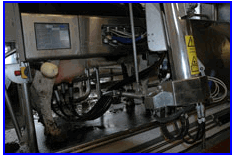



Milking with Robots
By Marcia Endres, Extension Dairy Scientist, University of Minnesota, Dairy Extension. There is increasing interest in automatic milking systems (AMS) in the U.S. even though the cost:benefit ratio is not yet as good here as it is in some of the European countries.But it is a lifestyle choice that is attractive to some producers. At the annual National Mastitis Council (NMC) meeting in New Orleans this past January there was a session on ‘looking at robotic milking from a variety of angles’. Dutch researchers reported that more than 4,000 farms worldwide were using robots in 2006. That number is growing. In some northwestern European countries, more than 50% of new milk installations are automatic milking systems. The costly aspect of robots is not in steel or other materials, but in electronics. It is expected that, over time, robots will become relatively less expensive. Reasons for investing in an AMS are reduction in labor, and more labor flexibility and free time, which, in general, result in a better quality of life.
 |
| Robotic milking unit at Mason-Dixon's dairy |
Two dairy producers shared their experience with milking robots at the NMC meeting. Doyle Waybright from Mason Dixon Farms in Pennsylvania represented a large herd perspective. They are milking approximately 600 cows with 10 robots. Their AMS operation started in November 2005. Their goal is to milk 2000 cows with 40 robots. The units they are using are DeLaval Voluntary Milking Systems. The freestall barn was designed for cow comfort and optimal utilization of the robots. Each pen houses 60 or 120 head for the entire lactation with their own robot unit at the ends of the pens. They are using a milking-feeding traffic system and feed cows three times a day to attract cows to the robot. The TMR is formulated for 70 lbs of milk and additional concentrate is fed in the AMS according to stage of lactation. They allow up to four times per day milking. Once mature cows and first-calf heifers are trained, the only milking labor required is fetching 1 to 2% of cows that were not milked. Skilled labor is required to maintain the robots and interpret the computer’s daily reports. Doyle indicated that one goes from ‘herding’ to ‘individual cow’ management when using an AMS. Some cows will not adapt to a robot due to temperament or udder traits including close rear teat placement. Other interesting features in their barn include elevated feeding stalls at the feed bunk, automatic manure scraping to help keep feet drier, tunnel ventilation for summer, excellent lighting, and well-bedded and well-designed freestalls. It looks like they are providing a very comfortable, low stress environment for their cows.
John Keurentjes from Quebec, Canada, represented a small producer perspective. They are milking 120 cows with two robots using Lely robotic milking technology. They started their AMS system in 2002 with 80 cows. The units have individual teat cups, coming off when a quarter is done, so there is no chance of overmilking. All cows are milked with the robots, including all fresh cows, sick cows, and cows to dry up. Milk is diverted as needed. They have very low incidence of mastitis, with only 1 to 2 cases in the summer months. John has noticed that cows are much more relaxed than before when they were milked in the parlor. They walk through the cows four times a day to clean freestalls and fetch cows not milked. It takes them about 15 minutes. Cows are managed as individuals, not groups. He said, “Each cow has the freedom of her own actions — when to eat and drink, lie down, walk, get groomed, and get milked. They live in a free traffic system and can set their own agenda.” The Keurentjes seldom move a cow from one pen to the other, so there is no regrouping stress. They feed a partial TMR once a day, and push up feed three times a day. All cows have access to a concentrate mix in the robot fed according to production level. Cows get milked an average of 2.8 times per day with only a 1.25% failure rate on the total milkings in the herd. John summarized his experience by saying that “robotic milking creates a new lifestyle. Home at 5 p.m. is not unusual, nor is spending your evenings with your spouse and children. Robotic milking puts the well-being of the cows and farmers to the forefront like never before.”



